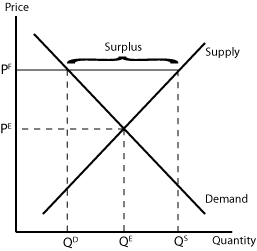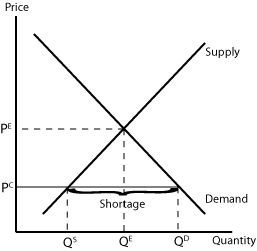|
|
| ||
Price Floors and Ceilings
Price Floors and Price Ceilings are Price Controls, examples of government intervention in the free market which changes the market equilibrium. They each have reasons for using them, but there are large efficiency losses with both of them.
Price Floors
Price Floors are minimum prices set by the government for certain commodities and services that it believes are being sold in an unfair market with too low of a price and thus their producers deserve some assistance. Price floors are only an issue when they are set above the equilibrium price, since they have no effect if they are set below market clearing price.
When they are set above the market price, then there is a possibility that there will be an excess supply or a surplus. If this happens, producers who can't foresee trouble ahead will produce the larger quantity where the new price intersects their supply curve. Unbeknownst to them, consumers will not buy that many goods at the higher price and so those goods will go unsold.
There will be economic harm done even if suppliers can look ahead and see that there isn't sufficient demand and cut back on production in response. There is still deadweight loss associated with this reduction in quantity, reflected in the loss of consumer and producer surplus at lower levels of production. Producers can gain as a result of this policy, but only if their supply curve is relatively elastic and therefore they have no net loss. Consumers will definitely lose with this kind of regulation, as some people are priced out of the market and others have to pay a higher price than before.
There are numerous strategies of the government for setting a price floor and dealing with its repercussions. They can set a simple price floor, use a price support, or set production quotas. Price supports sets a minimum price just like as before, but here the government buys up any excess supply. This is even more inefficient and costly for the government and society as a whole than the government directly subsidizing the affected firms. Production quotas artificially raise the price by restricting production using either mandated quotas or giving businesses incentives to reduce their production. In America, this latter technique is used widely with agriculture. The government pays farmers to keep some portion of their fields fallow, thus elevating prices. Like price supports, the policy would be more efficient and less costly to society if the government directly subsidized farmers instead of setting a production restriction.

Price Ceilings
Price Ceilings are maximum prices set by the government for particular goods and services that they believe are being sold at too high of a price and thus consumers need some help purchasing them. Price ceilings only become a problem when they are set below the market equilibrium price.
When the ceiling is set below the market price, there will be excess demand or a supply shortage. Producers won't produce as much at the lower price, while consumers will demand more because the goods are cheaper. Demand will outstrip supply, so there will be a lot of people who want to buy at this lower price but can't. Still, if the demand curve is relatively elastic, then the net effect to consumer surplus will be positive. Producers are truly harmed, as their surplus is doubly hit with a reduction in the number of firms willing to take that lower price, and those who remain in the market have to take a lower price.
The resulting shortage of goods can lead to consumers having to queue up in line to get the good, government rationing, and even the development of a black market dealing with the scarce goods. This is what occurred with the energy crisis in America during the 1970s, when cars had to line up on the street in order to just get some government rationed amount of gasoline.

| Copyright 2006 Experimental Economics Center. All rights reserved. | Send us feedback |



